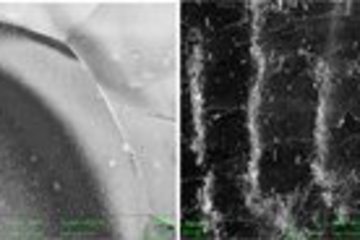All genres
1.
Journal Article
Nanoscale mechanisms limiting non-basal plasticity in magnesium. Acta Materialia 296, 121261 (2025)
2.
Journal Article
Free, flexible and fast: Orientation mapping using the multi-core and GPU-accelerated template matching capabilities in the Python-based open source 4D-STEM analysis toolbox Pyxem. Ultramicroscopy 237, 113517 (2022)
3.
Journal Article
Forging strength–ductility unity in a high entropy steel. Journal of Materials Science & Technology 113, pp. 158 - 165 (2022)
4.
Journal Article
Understanding Alkali Contamination in Colloidal Nanomaterials to Unlock Grain Boundary Impurity Engineering. Journal of the American Chemical Society 144 (2), pp. 987 - 994 (2022)
5.
Journal Article
Controlled Doping of Electrocatalysts through Engineering Impurities. Advanced Materials, 2203030 (2022)
6.
Journal Article
Automated Crystal Orientation Mapping by Precession Electron Diffraction-Assisted Four-Dimensional Scanning Transmission Electron Microscopy Using a Scintillator-Based CMOS Detector. Microscopy and Microanalysis 27 (5), pp. 1102 - 1112 (2021)
7.
Journal Article
Investigation of the orientation relationship between nano-sized G-phase precipitates and austenite with scanning nano-beam electron diffraction using a pixelated detector. Scripta Materialia 201, 113930 (2021)
8.
Journal Article
Crystallographic Orientation Analysis of Nanocrystalline Tungsten Thin Film Using TEM Precession Electron Diffraction and SEM Transmission Kikuchi Diffraction. Microscopy and Microanalysis 27 (2), pp. 237 - 249 (2021)
9.
Journal Article
Prospects of using small scale testing to examine different deformation mechanisms in nanoscale single crystals - A case study in Mg. Crystals 11 (1), 61 (2021)
10.
Journal Article
Self-toughened high entropy alloy with a body-centred cubic structure. Nanoscale 13, pp. 3602 - 3612 (2021)
11.
Talk
Advanced transmission electron microscopy of nanomaterials using In-situ TEM and precession electron diffraction. Seminar, Korea Institute of Industrial Technology (KITECH), Seoul, South Korea (2019)
12.
Talk
Advanced transmission electron microscopy of nanomaterials using In-situ TEM and precession electron diffraction. Seminar, Korea Institute of Materials Science (KIMS), Seoul, South Korea (2019)
13.
Talk
Advanced transmission electron microscopy of nanomaterials using In-situ TEM and precession electron diffraction. Seminar, Korea Institute of Science and Technology (KIST), Seoul, South Korea (2019)
14.
Talk
Advances in automatic TEM based orientation mapping with precession electron diffraction. KSM Annual Fall Conference 2019, Gyeongju, South Korea (2019)
15.
Talk
In-situ TEM observation of twin-dominated deformation of Mg single crystals. KSM Annual Fall Conference 2019, Gyeongju, South Korea (2019)
16.
Talk
Development and applications of a high temperature nano-/micro mechanics device with a novel temperature measurement approach. Euromat 2019, Stockholm, Sweden (2019)
17.
Talk
Advances in automatic TEM based orientation mapping with precession electron diffraction. Joint Max-Planck-Institut für Eisenforschung MPIE) / Ernst Ruska-Centre (ER-C) Workshop, Düsseldorf, Germany (2019)
18.
Poster
Advances in automatic TEM based orientation mapping with precession electron diffraction. International Workshop on Advanced In Situ Microscopies
of Functional Nanomaterials and Devices (IAMnano 2019), Düsseldorf, Germany (2019)











